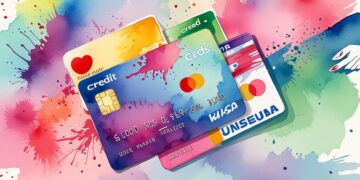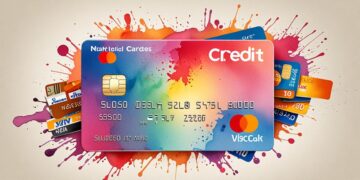Credit Cards and Security: Protecting Yourself Against Fraud and Financial Losses

The Importance of Credit Card Security in the Digital Age
In recent years, credit cards have evolved into an essential tool for financial transactions, influencing how consumers purchase goods and services. The convenience offered by credit cards, such as the ability to shop online or make quick payments at physical retail locations, has led to their widespread adoption. Additionally, many credit cards provide consumers with rewards programs—including cash back, travel points, and other incentives—that further encourage usage. However, these benefits come with inherent risks, particularly regarding fraudulent activities and security breaches.
Understanding Common Security Threats
As reliance on credit cards grows, so does the sophistication of threats facing cardholders. Awareness of these potential risks is crucial for protecting personal and financial information. Below are some prevalent issues:
- Identity Theft: This occurs when someone unlawfully obtains your personal information, such as Social Security numbers, bank details, or credit card information, to establish new credit accounts in your name. A report by the Federal Trade Commission (FTC) revealed that identity theft was one of the most common forms of consumer complaints in the United States.
- Phishing Scams: These scams involve fraudulent communications, often via email, that mimic reputable entities like banks or retail brands. Attackers create convincing messages to entice individuals to click on malicious links or provide personal information, leading to unauthorized access to their accounts.
- Skimming: This technique involves the use of unauthorized devices, or “skimmers,” placed over card readers at ATMs or gas pumps. These devices record card information during legitimate transactions, which fraudsters later exploit to create cloned cards.
Effective Strategies for Cardholder Protection
Implementing preventative measures can significantly enhance your financial security and deter potential threats. Consider the following strategies:
- Monitor Account Activity: Frequent review of transaction history allows consumers to quickly identify any unauthorized charges. Many banks offer online banking applications that provide alerts for real-time spending notifications, enabling immediate responses to suspicious activity.
- Use Secure Connections: Always ensure that the websites you visit for transactions are secure, indicated by “https://” in the URL. Avoid using public Wi-Fi for entering credit card information, as unsecured networks can expose you to data breaches.
- Activate Alerts: Most credit card providers offer features to set up notifications for purchases or withdrawals. By having alerts sent to your mobile device or email, you can swiftly identify and report any unauthorized usage.
By remaining informed and assertive in taking security precautions, consumers can better shield themselves from financial losses associated with credit card fraud. Incorporating these practices not only protects personal and financial information but also fosters a more secure financial landscape for all card users. In today’s digital age, being proactive is more critical than ever to safeguard against the evolving nature of financial threats.
DIVE DEEPER: Click here to discover sustainable investment strategies
Recognizing the Signs of Fraud
Understanding fraud detection is essential for effective credit card security. Fraudulent activities can be subtle and may not always be immediately noticeable, but being able to recognize the early signs can greatly aid in mitigating potential losses. Here are some indicators that may signal unauthorized use of a credit card:
- Unfamiliar Transactions: One of the most apparent signs of fraud is the presence of unfamiliar charges on your credit card statement. Regularly scrutinizing your transaction list will help you catch unauthorized purchases before they escalate.
- Declined Transactions: If your card is unexpectedly declined, especially if you are certain of having sufficient funds or credit available, it could be a red flag that your account has been compromised. Contact your financial institution immediately to investigate the matter.
- Missing or Altered Statements: If you notice that your monthly statements are missing or if they contain altered or suspicious information, this could indicate that someone has accessed your account without permission. Always report such discrepancies to your card issuer.
- Account Lockout: Difficulty accessing your online banking or credit account could imply that someone may have attempted to change your login credentials. If you are locked out, contact your bank to promptly regain access and assess the security of your account.
Being proactive about spotting these signs can significantly reduce your vulnerability to fraud. It is recommended that consumers maintain a habit of regular monitoring of their financial statements and online accounts. Setting up a schedule to check account activity, such as once a week, allows for timely detection of any irregularities.
Proactive Measures to Mitigate Risk
In addition to recognizing signs of fraud, consumers must implement proactive measures to safeguard their personal and financial information. Here are several strategies that can help mitigate risk:
- Utilize Strong Passwords: Create complex passwords that combine letters, numbers, and symbols, making it harder for unauthorized users to break into your accounts. Avoid using easily guessed personal information, such as birthdays or names.
- Enable Two-Factor Authentication: Most credit card providers now offer two-factor authentication as an added layer of security. This involves an additional verification step beyond a password, such as receiving a code via SMS, making it much more difficult for scammers to access your account.
- Consider Virtual Card Numbers: Some banks offer virtual card numbers for online transactions. These temporary numbers can be used instead of your actual credit card information, reducing the risk of exposure should a site be compromised.
Through the use of these proactive strategies, consumers can fortify their defenses against the ever-evolving threats posed by fraudsters. By remaining vigilant and informed, individuals can protect their financial interests and navigate the landscape of credit card usage with greater confidence. In the digital age, it is essential to adopt a comprehensive approach to credit card security to minimize vulnerability to fraud and potential financial losses.
DISCOVER MORE: Click here to learn about the impact of financial education</p
Responding to Fraud: Steps to Take Immediately
In the event that you suspect or confirm unauthorized activity on your credit card, it is crucial to take immediate action to minimize potential financial losses. The following steps outline a comprehensive approach to effectively respond to fraud:
- Contact Your Credit Card Issuer: As soon as you identify any suspicious transaction, contact your credit card issuer. Most companies have dedicated fraud departments available 24/7 to assist customers. Reporting the fraud promptly can lead to quicker resolution and may prevent further unauthorized charges.
- Review Your Transactions: Conduct a thorough review of your recent transactions. Identify all unauthorized charges and document any supporting evidence, such as dates and amounts. This information will be vital when discussing the issue with your card issuer.
- Dispute Unauthorized Charges: After reporting fraud to your credit card issuer, formally dispute any unauthorized charges. Under the Fair Credit Billing Act, consumers are generally only liable for up to $50 in fraudulent transactions, provided that they report the fraudulent activity in a timely manner.
- Check Credit Reports: Regularly monitor your credit reports for any unfamiliar accounts or inquiries that may indicate identity theft. In the United States, consumers are entitled to one free credit report per year from each of the three major credit bureaus—Equifax, Experian, and TransUnion. Consider utilizing this resource to assess any discrepancies.
- Place a Fraud Alert: If you suspect that your personal information has been compromised, consider placing a fraud alert on your credit report. This alert notifies potential creditors to take extra measures to verify your identity before granting credit. The alert lasts for one year and can be renewed as needed.
- Consider Identity Theft Protection Services: Purchasing an identity theft protection service can provide an additional layer of security. These services typically monitor your accounts for suspicious activity and can assist in the recovery process if your identity is compromised.
Educating Yourself About Scams and Phishing Attempts
Staying informed about the latest scams and phishing tactics can significantly bolster your defenses against credit card fraud. Scammers continuously evolve their methods, and recognizing these threats is essential in protecting yourself. Here are some prevalent scams to be aware of:
- Phishing Emails: Scammers often disguise themselves as legitimate businesses and send emails requesting personal or financial information. Be cautious of emails that contain urgent requests or suspicious links. Always verify the sender’s email address and access the company’s website directly rather than through links in the email.
- Phone Scams: Fraudsters may call posing as representatives from your credit card company or other financial institutions. They often ask for sensitive information, such as your Social Security number or account details. Never disclose personal information unless you are sure of the caller’s identity—hang up and call back using known numbers from official sources.
- Fake Wi-Fi Networks: Public Wi-Fi can be a hotspot for fraud. Scammers may set up fake networks to intercept sensitive information. Avoid conducting financial transactions over public networks, or utilize a virtual private network (VPN) for additional security.
- Credit Card Skimming: Criminals often use devices called skimmers to capture card information at gas stations or ATMs. Always inspect the card reader for any unusual attachments or signs of tampering before inserting your card.
By educating yourself on these evolving tactics and responding promptly to any signs of fraud, you enhance the protection of your personal and financial information. Awareness and immediate action are your best allies in the ongoing battle against credit card fraud.
EXPLORE MORE: Click here for insights on financial education
Conclusion
In today’s fast-paced digital economy, the need for robust credit card security measures has never been more critical. Credit cards offer convenience, but they also expose consumers to potential fraud and financial losses. Understanding the inherent risks and implementing proactive strategies is essential for safeguarding personal and financial information. Regular monitoring of account activity, maintaining updated contact details with your card issuer, and actively disputing unauthorized transactions are fundamental practices that can significantly mitigate risks. Additionally, fostering awareness about common scams, such as phishing and skimming, empowers consumers to make informed decisions and recognize threats as they arise.
Utilizing available resources, including free annual credit reports and considering identity theft protection services, can further strengthen your defenses. The importance of prompt action cannot be overstated; responding swiftly to any signs of fraudulent activity can limit liability and facilitate a smoother resolution process. As cyber threats continue to evolve, staying informed and vigilant is your best line of defense. By adopting these measures, you not only protect yourself against financial setbacks but also contribute to a broader culture of security and awareness that ultimately benefits all consumers. In this interconnected age, vigilance and education are vital; being equipped with knowledge and resources will empower you to navigate the landscape of credit card use safely and securely.

Linda Carter is a writer and financial expert specializing in personal finance and financial planning. With extensive experience helping individuals achieve financial stability and make informed decisions, Linda shares her knowledge on the our platform. Her goal is to empower readers with practical advice and strategies for financial success.





